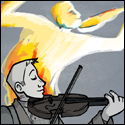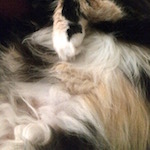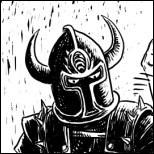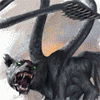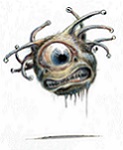|
Sounds like a ripoff.
|
|
|
|

|
| # ? Apr 29, 2024 19:24 |
|
Okay, I'm going to talk some about Empire of The Petal Throne, which has been rebranded as , Tekumel: The Empire of The Petal Throne, under the correct assumption that no one will ever find it otherwise. I will be focusing primarily on mechanics from the first part, basically characters, because that's what I care most about. The format of the book is that it is divided into 3 sections along roughly the same lines as the little brown books of OD&D. Being first published in 1975, there are a great number of similarities between Tekumel and OD&D. Character 'Types' Players can choose two alignments Good and Evil. I like this less than law and chaos, but it's probably tied pretty close to the setting. They may choose their sex, male or female. Oddly, this is lent the same precedence in the paragraph as the other decisions. They can choose one of three professions Warrior, Priest, and Magician. Unsurprisingly, Warrior is the booby prize here for people that roll poorly on their stats. "Some players may also wish to play as nonhuman intelligent beings, and this is permitted, although it is not possible to begin as a non- or semi-intelligent fauna, and inanimate object (e.g. a magic sword), a supernatural being or undead creature, etc." Interestingly, playing as a nonhuman is virtually identical to playing as a human except that they tend start with more than one hit dice and have an xp adjustment so that they end up with the same number of hit dice as humans. Presumably, they also roll on the slightly different nonhuman attack roll chart. The reason this is strange is that nonhuman races in Tekumel are not classic dwarves/elves and a lot of them tend to have a bunch of additional limbs, like the insectoid pe choi. You can play a flying squirrel with a poison spiked tail, but it's not clear whether you can use either of those powers because they're only in the monster entry. Basic Talents These are attributes. There are six of them, but not all the ones you would expect. They're rolled as percentiles, and the game doesn't have a specifically stated general resolution mechanic, roll under is alluded to a couple of times. The 'Basic Talents' are Strength, Intelligence, Constitution, Psychic Ability, Dexterity, and Comeliness. All of the talents except for psychic ability and comeliness have the effect of increasing or decreasing your hit dice and/or damage dice (by up to 2 depending on the Talent). I'm pretty sure 'hit dice', here refers to rolling to hit and not rolling for HP, although both are called Hit Dice. Low intelligence prevents you from using high level spells and magic wand items (called "Eyes" in Tekumel). Extremely high values give you a limited chance to find secret doors and detect traps. Constitution governs the chance that a revive spell will work, and at extremely high values gives you bonus HP when healed. Low psychic ability restricts spells (to none at a value of 20 or less) but at higher levels reduces your spell failure chance (which is significant as we'll see later). Low dexterity gives you a small chance to attack the wrong target with melee or spells. (Strap in because that isn't even he craziest rule I'm going to go over.) Extremely high Comeliness, will get you "carried off by various religious groups for participation in orgies, etc." When you level up you get a 20% chance to increase one of your Basic Talent, chosen at random, by 5%. If you're paying attention you've noticed that spell casting is dependent on both Intelligence and Psychic Ability, and almost all the Talents effect chance to hit, so the entire game is MAD. Original Skills There are three categories of background skills: Plebeian, Skilled, and Noble. You roll percentile dice to determine how many you start with. You can choose any from a given list that you want. The roll range is if you roll a 1-35 you get 1 Plebian skill. If you roll 96-100 you choose 4 Plebeian skills and 3 each of Skilled and Noble. Plebian includes such options as butcher, baker, and Some of the Noble skills have specific abilities listed like making potions for alchemist, or hide in shadows for assassin-spy-tracker. Most of these are governed by the spell failure chance chart we'll see later. When leveling up there is a 50% chance of learning an Original Skill, the category of skill learned depend on level with the player getting free choice of which group by 8th level. You can also buy training in these in the game world for some reason, separately from gaining them by leveling. Specific Professional Skills  This is the interesting part. Read this part. This is the interesting part. Read this part. These are class skills. Each class, warrior, priest and magic user has a list of 12 skills. Players roll percentile dice to determine the number known at the start. A roll of 1-20 results in starting with 2 of the first 3 skills, and a roll of 96-100 results in starting with 5 of the first 7 skills. Unlike the previous two categories that don't always increase you have a 100% chance each level up to get the lowest item on your classes list that you don't already know. The warrior list is predictably terrible with most of the items being proficiency in a weapon like "crossbowman". However, the bottom of the list is interesting capping out with the following: Two handed fighting (with a dagger), sapper, arrtileryman, and strategist (i.e. literally an army leader) The priest list and the magic user list are mostly filled with spells some of which can be used multiple times a day. Priest starts out with language knowledge, but gets light, cure light wounds, telepathy, and caps out with remove curse and revivify (which is the resurrection spell). Magic User gets illusion, clairvoyance, telekinesis, and caps out with a 1/day touch attack that turns someone into ash with no save. The interesting thing about this Original Skills list is that, there is a list of spells that all magic users can be expected to always have (depending of course on level). Regeneration of Spells and Likelihood of Their Working Spellcasters automatically regain the use of all their spells at 6 AM. Simple and easy to understand (as long as the world is flat). Here comes the crazy bit: "For both priests and magic users there is also the chance of a spell NOT working." This is level based, 60 percent chance to fail at level 1, decreasing by 10% per level to 20 at level 5, and then by 5% to 0 at level 9. (The maximum bonus from Psychic Aptitude here is 15%.) Bonus Spells This part is also rather cruel. On leveling up spellcasters get to roll percentile dice once on a chart to see whether they can learn bonus spells from three groups of increasing power level. They can roll for Group 1 Spell, Group 2 Spell, Group 1 Spell and Group 2 Spell, Group 3 Spell, or Group 2 and Group 3 Spell in increasing order of difficulty, the difficulty also drops as characters increase in level. If you fail the roll, you get nothing of course. This spell list is shared between classes, and each group has about 20 spells in it. The player gets to choose the spell the learn when the succeed the roll. Group 1 has such spells as Heal Light Wounds (which is a duplicate from the Priest Original Skill except for the name), levitate, locate objects, bless, dispel illusion. Group 2 has such spells as charm, sleep, cold (which is an aoe attack spell), invisibility, haste. Group 3 has such spells as The energy bolt, Doomkill, Fly, Invulnerability, Walls. I just want to talk about the spell Walls for a moment, it allows you to conjure your choice of one of 7 different types of walls which moves slowly towards a target. For some reason, there are elaborate rules for the pokemon fight that apparently ensues when two opposing walls are shot at each other. The spell description is an entire page long because of this. What is going on here? Experience You know how this works, experience totals are similar for different classes in this game. The only weird thing is that higher level characters take an increasing penalty to the percentage of xp that they get, on top of the geometric xp chart, making it even more excruciatingly slow to get to high levels. Hit Dice At level 10 Warriors have 10+4 HD, Priests 9+1, and Magic Users 8+1. Combat The familiar "men attacking" and " Priests can only use blunt weapons. Magic Users can only use leather armor, and wield daggers. Most weapons do d6 damage, except for daggers and darts which only deal d4. If you have a strength of 80 you can use specific weapons that deal d6+1, or a specific two handed weapon that deals d6+2 at strength 90. The two handed fighting rules (which require the Warrior skill above) are here and allow you to attack twice at a penalty of 1 to each attack (and your second weapon is a d4 dagger). There are a number of combat rules, morale (which is based solely on monster HD, and remaining forces), some regarding catapults, the number of fighters that can stand in a ten foot square by weapon, crtitical hits, even prototype grappling rules. Only one more rule really stood out to me which is a chart that allows higher level characters and monsters to roll more damage dice against lower level enemies. At level 4, you start dealing 2 damage dice to 1 HD enemies. The chart is skewed towards the attacker, so by level 9 you can still deal 2 damage dice to a 9 HD monster. The maximum number of dice is level 10 attacker against 1 HD gives 5 damage dice. This is one place where the Warrior has an advantage Priests and Magic Users use their level - 1 on the chart. For some reason this entire section ends with a description of how gladiatorial arenas work in Tekumel. It specifies that all fights are to the death with appropriate weapons and only against someone with the same profession and class as you. Also you can forgo using spells if you want. So, wizard knife fights. DalaranJ fucked around with this message at 16:21 on Apr 29, 2018 |
|
|
|
Payndz posted:Well holy crap, I actually managed to do it. You All Meet In A Tavern is here, at v0.1 status ready to be examined and poked with sharp sticks. Comments welcome! This looks pretty cool. What would be the best way to run it for the first time? (or if it's not quite ready, maybe TAAC?) Gort fucked around with this message at 15:04 on Apr 29, 2018 |
|
|
|
DalaranJ posted:Players can choose two alignments Good and Evil. I like this less than law and chaos, but it's probably tied pretty close to the setting. Thanks for the effortpost. I guess they've moved to Stability and Change now? Stability and Change are better descriptors than Good and Evil. On the other hand the 'Change' deities are prettttty loving evil.
|
|
|
|
Gort posted:This looks pretty cool. What would be the best way to run it for the first time? (or if it's not quite ready, maybe TAAC?) Just one thing to bear in mind: combat in YAMIAT is way faster than in any version of D&D (I'd say it uses only a third to a half as many die rolls), and because every attack scores damage, it's deadly. If a converted adventure has Explorer-tier PCs heavily outnumbered by anything more than DD d4 trash opponents, I'd recommend reducing the number of enemies. (And use the Morale Check rules as well!)
|
|
|
|
Greg Gillespie has another megadungeon Kickstarter. Both his past projects have been great. http://kck.st/2KmXEaX
|
|
|
|
alg posted:Greg Gillespie has another megadungeon Kickstarter. Both his past projects have been great. I have the impression - only based on reviews and comments - that his past dungeons were quite standard D&D fantasy stuff (barbaric orcs, evil goblins, etc.) without a ton of novel ideas. Am I off-base? I'd love to back a giant floating dungeon, but if it's just going to be full of The Basic Fantasy Enemies, I'll probably pass.
|
|
|
|
Does anyone know if the Sigil guidebook has a poster map? I'm rebuilding my planescape collection, and it's one of the ones I'm missing, and now that I have the main four boxes, I'm not super precious about getting the original versions of other things, unless they had maps in them, which I know the POD process mangles by printing them as a bunch of pages.
|
|
|
|
BinaryDoubts posted:I have the impression - only based on reviews and comments - that his past dungeons were quite standard D&D fantasy stuff (barbaric orcs, evil goblins, etc.) without a ton of novel ideas. Am I off-base? I'd love to back a giant floating dungeon, but if it's just going to be full of The Basic Fantasy Enemies, I'll probably pass. He uses standard tropes but his monsters get fairly interesting. The undead in Barrowmaze were a lot more than stock zombies and skeletons. He uses the dungeon to tell an unfolding story through monsters and clues. What I really like is that it requires very little prep.
|
|
|
|
Anyone have any suggestions on what to pick up here for someone just getting started on exploring OSR material? http://www.drivethrurpg.com/sale.php?&filters=0_0_0_0_0_45711 Thinking about picking up the DCC book and the Rules Cyclopedia
|
|
|
|
Mike Danger posted:Anyone have any suggestions on what to pick up here for someone just getting started on exploring OSR material? http://www.drivethrurpg.com/sale.php?&filters=0_0_0_0_0_45711 Thinking about picking up the DCC book and the Rules Cyclopedia http://www.drivethrurpg.com/product/238925/2018-ConTessa-Bundle-of-Awesome-BUNDLE has some great poo poo.
|
|
|
|
I would always suggest DCC, it's the most fun I've had with an RPG
|
|
|
|
Mike Danger posted:Anyone have any suggestions on what to pick up here for someone just getting started on exploring OSR material? http://www.drivethrurpg.com/sale.php?&filters=0_0_0_0_0_45711 Thinking about picking up the DCC book and the Rules Cyclopedia What games are you coming from?
|
|
|
|
DalaranJ posted:What games are you coming from? The normal stuff. D&D, Dungeon World. Mostly I have been reading False Machine/Goblin Punch a whole lot. (And yeah, I saw Veins of the Earth in that bundle, Megazver)
|
|
|
|
Harvey Stroh's DCC modules are the good ones, apparently. And the other good OSR stuff in that bundle are the Hot Springs books, the Hydra Cooperative stuff and Sharp Swords & Sinister Spells. Megazver fucked around with this message at 19:06 on May 3, 2018 |
|
|
|
Mike Danger posted:The normal stuff. D&D, Dungeon World. Mostly I have been reading False Machine/Goblin Punch a whole lot. (And yeah, I saw Veins of the Earth in that bundle, Megazver) Yeah, rules cyclopedia is real good, that’s B/X. You can get a free version of Swords & Wizardry for AD&D (although AD&D seems to be the system with the most competition.) an For Gold and Glory for a 2e clone. I don’t assume anyone’s gaming origin since I would have never considered OSR games without reading the essays of Ron Edwards.
|
|
|
|
Isn't S&W OD&D?
|
|
|
|
It’s OD&D plus all the supplements, which ends up looking quite a bit like AD&D. The White Box edition is closer to the actual original three books.
|
|
|
|
Cyclopedia is BECMI rather than B/X fwiw - not sure that makes a difference to you. Patrick Stuart's writing is brilliant - deep carbon observatory might be my the best module I've read, though I haven't yet run it and can't review it from that perspective.
|
|
|
|
Mike Danger posted:Anyone have any suggestions on what to pick up here for someone just getting started on exploring OSR material? http://www.drivethrurpg.com/sale.php?&filters=0_0_0_0_0_45711 Thinking about picking up the DCC book and the Rules Cyclopedia The Nightmares Underneath and it's expansion The Nameless Grimoire are both excellent
|
|
|
|
I see Beyond the Wall is on there; I'm not sure I'd call it OSR per se, but it's still an excellent game at an excellent price. Also, everything from Sine Nomine publishing is awesome - my personal favourite is Spears of the Dawn. I'd honestly suggest the BECMI Rules Cyclopaedia over AD&D 1e - it's better organised, the mechanics are better (IMO), and it has mechanics for becoming a god. If you don't mind stepping a little away from D&D, I would also recommend taking a look at RuneQuest Classic (here) - it's a reprint of the second edition of the game, which was itself basically a better edited reprint of the first. Since the first edition came out in 1978 and the second came out in 1980, I'd definitely say it counts as OSR  . .
|
|
|
|
hectorgrey posted:I see Beyond the Wall is on there; I'm not sure I'd call it OSR per se, but it's still an excellent game at an excellent price. Also, everything from Sine Nomine publishing is awesome - my personal favourite is Spears of the Dawn. Although if you're interested in the system, the Mythras bundle might be a better investment: https://bundleofholding.com/presents/Mythras
|
|
|
|
whydirt posted:It’s OD&D plus all the supplements, which ends up looking quite a bit like AD&D. The White Box edition is closer to the actual original three books. Oops.
|
|
|
|
Megazver posted:Although if you're interested in the system, the Mythras bundle might be a better investment: Personally, I like both and am looking forward to the next edition too. Still, a bundle is certainly a cheaper way to get stuff, and Mythras might be the more newbie friendly introduction to the system...
|
|
|
|
hectorgrey posted:Also, everything from Sine Nomine publishing is awesome - my personal favourite is Spears of the Dawn.
|
|
|
|
While searching for something else the other night I found this for use in my 4E group. Most of us have laptops and/or touchscreens. https://www.microsoft.com/en-us/store/p/character-viewer/9wzdncrdlz0v We've now tested its functionality at the table and it went off without a hitch for 6/7 people. The seventh guy had weird display problems with it on his laptop where some of the powers overlapped.
|
|
|
|
Angrymog posted:Does anyone know if the Sigil guidebook has a poster map? I'm rebuilding my planescape collection, and it's one of the ones I'm missing, and now that I have the main four boxes, I'm not super precious about getting the original versions of other things, unless they had maps in them, which I know the POD process mangles by printing them as a bunch of pages. Not that I know of, not in that particular style. I've found a number of pretty good ones online, however. The very first image has a solid, wrapping map with labeled streets, major buildings of note, and even where the various businesses and buildings may be found in other books.
|
|
|
|
What is the history of “skills” pre-3e, what circumstances led to their codification?
|
|
|
|
There were thief skills ever since the thief class was introduced. AD&D 2e and BECMI both included non-weapon proficiencies. I suspect the main thing that led to that codification was just the fact that there were two separate systems for essentially the same thing.
|
|
|
|
I guess I'll make this where I go for Godbound discussion, yeah? I'm setting up my campaign starter in a new ruined city I've devised, set in Ancalia. I am making a Parasite God who was an architect in life. He's weak - I mean, all of his worshippers died and got turned into undead, so what can you do, eh? But I want to make it so he's not a creepy dude in a ruin or whatever; I want him to be a still in-tact small-to-mid-sized modern-looking steel-and-glass building. Like, he doesn't live in this building; he is this building. He'll be able to create twisted automatons, naturally. And I was thinking for his attacks, maybe animating, like, giant sawblades or whatever against anyone unwise enough to step past his threshold. I expect I will have the opportunity to use phrases like 'non-euclidean geometry' a few times, too. (He's also effectively dominated a Nezdohvan ship full of clockwork scavengers and now has a metal army, if that matters. They picked the wrong city to dock in.) My first question - is this too weird, like, in a bad way? Second - what sorts of things would you pull with him? I know Godbound may not be what everyone knows, so 'in a general OSR sense' is fine and I can adapt.
|
|
|
|
dwarf74 posted:I guess I'll make this where I go for Godbound discussion, yeah? I'm setting up my campaign starter in a new ruined city I've devised, set in Ancalia. Sounds cool and not excessively weird. I don’t know Godbound at all, but thematically this seems like the perfect setup for a nightmarish funhouse dungeon with something the pcs need hidden inside. With an architect villain, it seems like traps and weird puzzles are justified, especially if there is a reason or incentive for the characters to have to go along with the buildings internal logic for part of the adventure. I'd have fun with falling elevators, doors to nowhere, shifting corridor mazes and at least one corridor of rotating knives. Are the characters powerful enough that they wouldn't have any reason to not play along? Gaining an advantage by figuring out the god's "design philosophy" seems like it's be a fun element. I've been reading Ballard and watching a lot of horror flicks lately, so my mind goes in a body horror by way of 70's dystopia direction. So trapping wise having parts of the building be semi-organic and function analogous to the human body comes to mind. Shutting down parts of the physical plant infrastructure might weaken the god pre-confrontation. Minions might have been repurposed into janitors (killer roombas) and the undead worshippers might be eerily going through the motions of life in a high rise planned live-work community, not attacking unless you cut in line or whatever. Okay, my media diet has rotted my brain. Mind if I steal this for one of my DCC games? It'd be an awesome pocket dimension to hide something in.
|
|
|
|
Glorified Scrivener posted:Mind if I steal this for one of my DCC games? It'd be an awesome pocket dimension to hide something in. Thanks for the ideas - yeah, I was thinking along those lines, too, but with Godbound heroes it's ah ... rough ... to keep them contained in any area or threaten them with relatively mundane stuff. And the macguffin is defeating the parasite god itself, so I'm hoping they don't immediately clue into the fact that he's not in the building, he is the building. I really dig your idea of janitors and whatnot. Kind of a circulatory and immune system sort of a deal. Nice.
|
|
|
|
DalaranJ posted:What is the history of “skills” pre-3e, what circumstances led to their codification? in AD&D 1e, players had Weapon Proficiencies. You had a few at level 1, you gained more as you leveled (with Fighters having the most, and everyone else having various degrees of less), and you'd take a nasty penalty to attack rolls if you tried to use a weapon that you weren't proficient with. Oriental Adventures introduced the idea of the Non-Weapon Proficiency (NWP)): there were these sets of skills which were largely supposed to model the character's capacity to perform special actions such as silk-making, iaijutsu, juggling, music, which the author probably felt was appropriate to capture in a game dealing with "Oriental" sensibilities. The basic idea was that if you wanted to do A Thing, and you had the appropriate NWP for it, you would roll a d20, and you would succeed if the result was equal to or less than the specified target number for the NWP. The target number would range between 10 (Swimming) to 19 (Painting), and you could take the same NWP multiple times to get a minus to your d20 roll (which makes success more likely). Dungeoneer's Survival Guide and Wilderness Survival Guide took this idea and ran with it: some of the more "camping/survivalist" skills from Oriental Adventures were carried over, but then they also added a bunch of more "dungeeoneery" skills, like blind-fighting, sound analysis, rope use, and animal noise. They also changed the system such that each NWP had a corresponding ability score (Swimming = Strength, Boating = Wisdom), and your ability score would be your target number, except some NWPs would modify your die roll on top of that. So if you had 15 Strength, then you'd need to roll a 15 or lower to succeed in a Swimming check. If you had 13 Wisdom, then you'd need to roll a natural 12 or lower to succeed in a Boating check, since Boating adds a +1 to your die rolls (making it harder). You could still take the NWPs multiple times to make it easier to succeed. By the time they got to AD&D 2e, the NWP system was written right into the PHB. It was still heralded as an optional system, and there's actually a long discussion in the book about how it would probably be more appropriate in lots of cases to simply assume levels of competency in players, to award success automatically, and to forego the NWP system completely, but later supplements would add so much to the NWP system that it wasn't really feasible to ignore it without hacking off a lot of what these supplements had and involved. The jump to 3e's d20 system was to move from this roll-under model (and, as hectorgrey mentioned, the Thief's percentile-roll under system), and move into the [d20+stat+ranks vs DC] model that we're all familiar with. The thief skills all got their respective equivalents, but a lot of the "skill bloat" that we saw in 3.0 (and would only be slightly lessened in 3.5) came from importing a lot of the NWPs from AD&D: animal handling, intuit direction, rope use, swimming, spellcraft, appraise, disguise, jump, survival, etc etc all got their start as AD&D NWPs.
|
|
|
|
Also in AD&D, PCs had Secondary Skills. Which worked a lot like Backgrounds, go figure!
|
|
|
|
Some NWPs did mildly cool things other than just being a skill check. Will elaborate at home when I can get my phb
|
|
|
|
Yeah, some skills in BECMI/RC were basically the precursor to feats (as was weapon mastery).
|
|
|
|
Angrymog posted:Some NWPs did mildly cool things other than just being a skill check. Will elaborate at home when I can get my phb Healing+Herbalism gave a lot of flexibility.
|
|
|
|
FRINGE posted:Healing+Herbalism gave a lot of flexibility. So let's talk about NWPs. Firstly, Every class group (Priests, Rogues, Warriors, and Wizards) got interesting stuff, and there was a comprehensive list that was available to all classes. Interestingly, unlike in 3+ Rogues get the least and the slowest progression 3 and 1/4 levels. Wizards and Priests are 4/3 and Warriors are 3/3. You also get bonus ones based on the number of languages your Intelligence score would give you. Some notable ones are... Animal Lore - Know about animals, interpret their behavior, find watering holes, specific animals, work out that everyone is running away from a forest fire, set snares, imitate animal noises. Animal training - Must be specialised to a type of animal. Teach an animal both general tasks (e.g. being ridden, guarding, attacking) and specific tricks (rearing on command, going for the eyes, etc...) Appraising - Know how much poo poo is worth to the nearest 100 or 1000gp and identify fakes. Artistic Ability - Select your art type. Also gives a +1 to music or dance checks, and to appraising works of art. Astrology - Do vaguely accurate horoscopes, good for up to a month. Book advised players to use at the end of the session to give their GM some time to prepare an answer. Also gives +1 navigation if you can see the stars Blind-fighting - Reduce penalties when fighting and operating in darkness, also makes it easier to fight invisible creatures Direction Sense - be a living compass Healing Can do battlefield healling once per character/per day, improves daily healing for someone under your care, can try and cure diseases and poisons too. Having Herbalism too improves and broadens the abilities that healing grants. Juggling No check needed for standard tricks. Allows the character to try and catch missles thrown at them by making an attack vs. AC 0. If the roll fails, they're automatically hit by the projectile. Riding - Split into Land and Air proficiencies, pretty much what you expect. Has rules for dropping off your airborne mount to the ground or another beast, and for using your land mount as a shield by hanging off the side. Set Snares - The setting of traps. Thieves can also set man traps, e.g. crossbows, deadfalls, spiked springboards and so on. Spellcraft - Identify spells, and spot Golems and other magical constructs. Tracking - doesn't do anything unexpected, but has really detailed rules Weapon Smithing - unlike the armor and bow equivalents, actually has prices. Longswords cost 10sp and take 30 days. A Dagger is 2sp and 5 days. Dagger sells for 2gp, Longsword for 15. Weather sense - Work out what the next six hours of weather are going to be like. You get a cumulative +1 bonus per 6 hours of observation until you do something like go to sleep, or head underground for a significant amount of time.
|
|
|
|
It's worth noting that anybody can take any non-weapon proficiency too (though naturally if it's not on one of your lists, you have to pay an extra slot to take it), meaning that you absolutely can play an intelligent Fighter who knows a lot of poo poo about a lot of poo poo. If you've ever read The Lord of the Rings, Aragorn isn't the experienced, mountaineer, Boromir is. D&D 3e onwards isn't really designed to deal with that kind of thing, but surprisingly enough 2e actually is - I would argue that in many ways it's actually more flexible in the kinds of characters you can build than 3.x is (though not quite as flexible as 5e unless you do a lot of house ruling). That said, what are people's opinions on the idea of a PC learning to use a weapon that their class doesn't normally get access to - either at first level or in play? At first level I'm inclined to be flexible with, say, the Wizard since they only get one weapon proficiency and a -5 penalty on all other weapons - seems letting them learn to use a light crossbow rather than a sling (or thrown daggers - something that seems to me to be far more difficult than learning to shoot with either a short bow or a light crossbow), but less so with the thief since they get a good selection of weapons and a lower penalty. In play, I'm not sure - maybe it would depend on the weapon, the class and the level?
|
|
|
|

|
| # ? Apr 29, 2024 19:24 |
|
I think the reason between the Rogues having fewer skill points in 2 and being skillmonkeys in 3+ is that in 3+ all the Thief skills are now skills they have to buy, but in 2 and older they were baked into the class.
|
|
|







